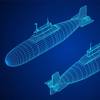The QinetiQ Platform Support Services Group is to fit ORPHEUS, a new navigational safety tool, to a Royal Navy frigate.
ORPHEUS will be installed on HMS Northumberland in August for year-long trials after demonstrations onboard a sistership, HMS Marlborough, proved a veritable success. QinetiQ will then install the system to two more Type 23 frigates, HMS Somerset and Montrose, later in the year.
ORPHEUS, an acronym for Onboard Risk Performance Hazard Evaluation System, is a dedicated and flexible operator guidance system that provides clear and concise information on how a ship will perform in a variety of heavy weather scenarios.
Taking thee years to develop, it displays measured motions, predictions of motions at alternative speeds, and heading combinations alongside operating limits.
MS Windows-based, the program combines real-time information with a database of previously generated data which, when selected, is plotted to a computer screen in a simple-to-use format.
The primary advantage of this operator guidance system is that it provides bridge staff with the means to quantify the risk of damaging, or ultimately losing the ship in extreme weather when performing certain duties. But it also allows officers to increase the operational envelope or improve operational safety of shipboard tasks that are normally hampered, even postponed, by the presence of harsh weather.
The sea keeping performance of naval shipping is a key enabler in delivering the operational capability. Operational requirements demand that mission effectiveness is maintained even in rough weather and that ships are able to survive extreme conditions. “Traditionally, operators have learnt how to handle and operate ships in heavy and extreme weather by two means. First from generalized seamanship classroom lectures given during training. However, current guidance is mainly formulaic, generic and based upon historical experience which rarely relates to modern ships and techniques. There is very little ship-class specific information provided which tends to consist of paper copies of a few graphs which have very limited use in situ.
“The second area is by learning from more senior watch keepers during prolonged periods at sea, but with time at sea reducing, combined with better forecasting, means that experience of extreme conditions will become more infrequent,” said QinetiQ Senior Scientist, and ORPHEUS Project Manager Alan Hodges.
“When initially developed – in collaboration with the UK Ministry of Defence Sea Technology Group (STG) – it was the Royal Naval bridge officer that QinetiQ had in mind. However, the system is equally pertinent to ships operating commercial trades, especially FPSOs and other specialist vessels that regularly carry aircraft or perform towing operations,” added Hodges.
Subscribe for
Maritime Reporter E-News
Maritime Reporter E-News is the maritime industry's largest circulation and most authoritative ENews Service, delivered to your Email five times per week










